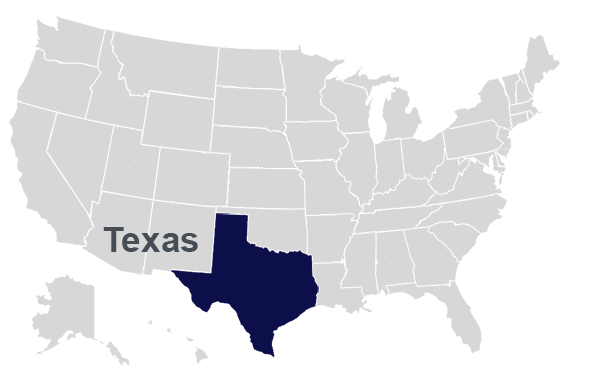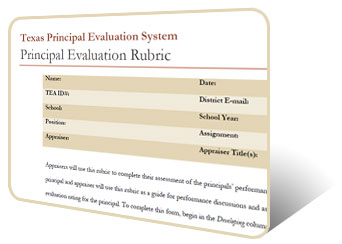Warning: Undefined variable $highlight_work in /var/www/html/web/txcc/our_work/tx_educator_evaluation/navigation.php on line 38
Warning: Undefined variable $highlight_teachers in /var/www/html/web/txcc/our_work/tx_educator_evaluation/navigation.php on line 43
Warning: Undefined variable $highlight_timeline in /var/www/html/web/txcc/our_work/tx_educator_evaluation/navigation.php on line 50
Warning: Undefined variable $highlight_committees in /var/www/html/web/txcc/our_work/tx_educator_evaluation/navigation.php on line 56
Principal Standards
(Texas Administrative Code, Title 19)
STANDARD 1 - Instructional Leadership: The principal is responsible for ensuring every student receives high-quality instruction.
Effective instructional leaders prioritize instruction and student achievement by developing and sharing a clear definition of high-quality instruction based on best practices from research. They implement a rigorous curriculum aligned with state standards. They analyze the curriculum to ensure that teachers align content across grades and that curricular scopes and sequences meet the particular needs of their diverse student populations. They model instructional strategies and set expectations for the content, rigor, and structure of lessons and unit plans. They routinely monitor and improve instruction by visiting classrooms, giving formative feedback to teachers, and attending grade or team meetings.
In schools led by effective instructional leaders, data are used to determine instructional decisions and to monitor progress. Principals implement common interim assessment cycles to track classroom trends and determine appropriate interventions. Staff have the capacity to use data to drive effective instructional practices and interventions. The principal's focus on instruction results in a school filled with effective teachers who can describe, plan, and implement strong instruction and classrooms filled with students actively engaged in cognitively challenging and differentiated activities.
INDICATORS:
- Rigorous and aligned curriculum and assessment: The principal implements rigorous curricula and assessments aligned with state standards, including college and career readiness standards.
- Effective instructional practices: The principal develops high-quality instructional practices among teachers that improve student performance.
- Data-driven instruction and interventions: The principal monitors multiple forms of student data to inform instructional and intervention decisions and to close the achievement gap.
STANDARD 2 - Human Capital: The principal is responsible for ensuring there are high-quality teachers and staff in every classroom and throughout the school.
Effective leaders of human capital treat faculty/staff members as their most valuable resource and invest in the development, support, and supervision of the staff. They ensure all staff have clear goals and expectations that guide them and by which they are assessed. They are strategic in selecting and hiring candidates whose vision aligns with their school's vision and whose skills match the school's needs. They ensure that, once hired, teachers develop and grow by building layered supports that include regular observations, actionable feedback, and coaching and school-wide supports so that teachers know how they are performing. They facilitate professional learning communities to review data and support development. They create opportunities for effective teachers and staff to take on a variety of leadership roles and delegate responsibilities to staff and administrators on the leadership team. They use data from multiple points of the year to complete accurate evaluations of all staff, using evidence from regular observations, student data, and other sources to evaluate the effectiveness of teachers and staff.
In schools with effective leaders of human capital, staff understand how they are being evaluated and what the expectations are for their performance. Staff can identify areas of strength and have opportunities to practice and receive feedback on growth areas from the leadership team and peers. Staff evaluation data show variation based on effectiveness but also show improvement across years as development and retention efforts take effect. Across the school, staff support each other's development through regular opportunities for collaboration, and effective staff have access to a variety of leadership roles in the school.
INDICATORS:
- Targeted selection, placement, and retention: The principal selects, places, and retains effective teachers and staff.
- Tailored development, feedback, and coaching: The principal coaches and develops teachers by giving individualized feedback and aligned professional development opportunities.
- Staff collaboration and leadership: The principal implements collaborative structures and provides leadership opportunities for effective teachers and staff.
- Systematic evaluation and supervision: The principal conducts rigorous evaluations of all staff using multiple data sources.
STANDARD 3 - Executive Leadership: The principal is responsible for modeling a consistent focus on and commitment to improving student learning.
Effective executive leaders are committed to ensuring the success of the school. They motivate the school community by modeling a relentless pursuit of excellence. They are reflective in their practice and strive to continually improve, learn, and grow. They view unsuccessful experiences as learning opportunities, remaining focused on solutions and are not stymied by challenges or setbacks. When a strategy fails, these principals analyze data, assess implementation, and talk with stakeholders to understand what went wrong and how to adapt strategies moving forward. They keep staff inspired and focused on the end goal even as they support effective change management. They have strong communication skills and understand how to communicate a message in different ways to meet the needs of various audiences. They are willing to listen to others and create opportunities for staff and stakeholders to provide feedback. They treat all members of the community with respect and develop strong, positive relationships with them.
In schools with effective executive leaders, teachers and staff are motivated and committed to excellence. They are vested in the school's improvement and participate in candid discussions of progress and challenges. They are comfortable providing feedback to the principal and other school leaders in pursuit of ongoing improvement, and they welcome feedback from students' families in support of improved student outcomes.
INDICATORS:
- Resiliency and change management: The principal remains solutions-oriented, treats challenges as opportunities, and supports staff through changes.
- Commitment to ongoing learning: The principal proactively seeks and acts on feedback, reflects on personal growth areas and seeks development opportunities, and accepts responsibility for mistakes.
- Communication and interpersonal skills: The principal tailors communication strategies to the audience and develops meaningful and positive relationships.
- Ethical behavior: The principal adheres to the educators' code of ethics in §247.2 of this title (relating to Code of Ethics and Standard Practices for Texas Educators), including following policies and procedures at his or her respective district.
STANDARD 4 - School Culture: The principal is responsible for establishing and implementing a shared vision and culture of high expectations for all staff and students.
Effective culture leaders leverage school culture to drive improved outcomes and to create high expectations. They establish and implement a shared vision of high achievement for all students and use that vision as the foundation for key decisions and priorities for the school. They establish and communicate consistent expectations for staff and students, providing supportive feedback to ensure a positive campus environment. They focus on students' social and emotional development and help students develop resiliency and self-advocacy skills. They treat families as key partners to support student learning, creating structures for two-way communication and regular updates on student progress. Regular opportunities exist for both families and the community to engage with the school and participate in school functions.
In schools with effective culture leaders, staff believe in and are inspired by the school vision and have high expectations for all students. Staff take responsibility for communicating the vision in their classrooms and for implementing behavioral expectations throughout the building, not only in their own classrooms. Teachers regularly communicate with the families of their students to provide updates on progress and actively work with families to support learning at home. Members of the broader community regularly engage with the school community.
INDICATORS:
- Shared vision of high achievement: The principal develops and implements a shared vision of high expectations for students and staff.
- Culture of high expectations: The principal establishes and monitors clear expectations for adult and student conduct and implements social and emotional supports for students.
- Intentional family and community engagement: The principal engages families and community members in student learning.
- Safe school environment: The principal creates an atmosphere of safety that encourages the social, emotional, and physical well-being of staff and students.
- Discipline: The principal oversees an orderly environment, maintaining expectations for student behavior while implementing a variety of student discipline techniques to meet the needs of individual students.
STANDARD 5 - Strategic Operations: The principal is responsible for implementing systems that align with the school's vision and improve the quality of instruction.
Effective leaders of strategic operations assess the current needs of their schools, reviewing a wide set of evidence to determine the schools' priorities and set ambitious and measurable school goals, targets, and strategies that form the schools' strategic plans. With their leadership teams, they regularly monitor multiple data points to evaluate progress towards goals, adjusting strategies that are proving ineffective. They develop a year-long calendar and a daily schedule that strategically use time to both maximize instructional time and to create regular time for teacher collaboration and data review. They are deliberate in the allocation of resources (e.g., staff time, dollars, and tools), aligning them to the school priorities and goals, and work to access additional resources as needed to support learning. They treat central office staff as partners in achieving goals and collaborate with staff throughout the district to adapt policies as needed to meet the needs of students and staff.
In schools with effective leaders of strategic operations, staff have access to resources needed to meet the needs of all students. Staff understand the goals and expectations for students, have clear strategies for meeting those goals, and have the capacity to track progress. Members of the staff collaborate with the principal to develop the school calendar. Teacher teams and administrator teams meet regularly to review and improve instructional strategies and analyze student data. Throughout the year, all staff participate in formal development opportunities that build the capacity to identify and implement strategies aligned to the school's improvement goals.
INDICATORS:
- Strategic planning: The principal outlines and tracks clear goals, targets, and strategies aligned to a school vision that improves teacher effectiveness and student outcomes.
- Maximized learning time: The principal implements daily schedules and a year-long calendar that plan for regular data-driven instruction cycles, give students access to diverse and rigorous course offerings, and build in time for staff professional development.
- Tactical resource management: The principal aligns resources with the needs of the school and effectively monitors the impact on school goals.
- Policy implementation and advocacy: The principal collaborates with district staff to implement and advocate for district policies that meet the needs of students and staff.



